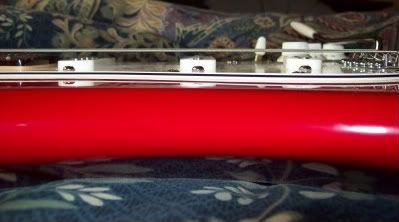Need measurements, What's the string hight at the 12th fret(low E) in 1/64in. What is the relief at the 7th fret in thousands?
Looks like that the trem is out of adjustment, the back of the bridge is too high off the face of the guitar. This raises the saddles up higher. Thus the strings.
Loosen the strings and put a wedge between the inertia block and the body at the rear of the inertia block. The inertia block is where the strings thread through. Set the wedge so that the face of the bridge is parallel to the face of the guitar.
Looking at the rear of the bridge, you shouldn't see a large gap. (Looking down the face from tail to neck)
String to pitch, the wedge should still be in place, if it falls out, loosen the spring claw screws a few turns until it stays in place. Retune.
Then, tighten the claw screws, evenly and slowly until the wedge loosens up.
This will get you in the ballpark.
Other bridge problems that I've seen...
Inertia block loosens from the bridge, Rare, the block is fastened to the bridge by screws under the saddles.
Pivot screws loose, check these. Tighten if needed. Carefully!
Bad springs, sometimes if you really use your trem a lot, these springs lose thier tension, replace if needed. If you have gone to a heavier guage string sometimes you have to add another spring. Vice-versa also. If you go to a lighter guage string, loosen the claw a little or remove a spring.
Check that the claw hasn't bent out, also rare, bend shorter or replace.
If you find that the claw is within 1/4" of an inch from the body, time for another spring or check for a bent claw.
Trem setup is a pain on a strat, but once it is in range, they work great.
I like a stiff trem, and the bridge parallel to the body, YMMV, some people like a easier trem with the ability to go up in pitch, that is not how Leo designed it, and it won't be like a Floyd Rose. It can be done a little, but is more persnickity to achieve and it won't have the same range. Also it will go out of tune a lot. Leos design just gives you a warbling type of action, no real drops. Works well as advertised. The way I describe setting gives good tuning stability and function.
Address the neck after setting the trem and remember that setting the relief with the truss bar will NOT affect the action a great deal. It will help but isn't meant to do major changes to the action. The truss bar just helps to insure that you are dealing with a relatively straight neck.
Did you take off the neck? Was there a shim between the neck and body that was forgotten. Another subject........ :roll:
Welcome to the wonderfully aggrivating world of Strat adjustments! :twisted:
When I die, I want to go peacefully in my sleep like my grandfather, not screaming......
like the passengers in his car.
Looks like that the trem is out of adjustment, the back of the bridge is too high off the face of the guitar. This raises the saddles up higher. Thus the strings.
Loosen the strings and put a wedge between the inertia block and the body at the rear of the inertia block. The inertia block is where the strings thread through. Set the wedge so that the face of the bridge is parallel to the face of the guitar.
Looking at the rear of the bridge, you shouldn't see a large gap. (Looking down the face from tail to neck)
:twisted:
It's a vintage style, six-screw Strat trem bridge set up for upbending as well as (normal) down-bending. The rear must be raised to "float" it a bit for two-way operation. While not as the original design intended (down-bend only) it is a popular way to set up this type of Strat trem.
The springs probably are okay (check his cavity pics further up).
But the inertia block could be loose. An interesting point.
-=tension & release=-
Can we get some specs please? and a shot of the neck like that last pic you just took.
Keep meaning to get back on here and say that I fixed the problem. First I replaced the neck, which only made the problem worse. I think when I had removed everything earlier, the original neck adjusted just enough to really highlight the need for a shim. Replaced the neck, and the shim necessity became more obvious.
Nothing wrong with the bridge. As was mentioned, it's a vintage style bridge set-up with the back end floating a bit for bending both ways... (Hey! None of that, get your mind out of the gutter :wink: .) Fender's Web site actually recommends setting up vintage bridges this way.
Thanks for the suggestions. If it comes up again, might mention adding a shim to adjust the neck tilt. Fixed it right up.
I'm sure it's good to have it back up and playing. Thanks for the mystery-solved update.
-=tension & release=-


